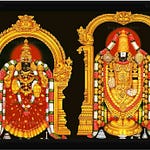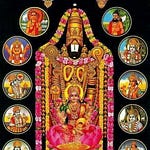Let us now begin with the Śrī Veṅkaṭeśa Suprabhātam of Śrī Prativādi-Bhayaṅkaram Aṇṇan Swāmī. As the name suprabhāta suggests, this is a “good morning” prayer addressed to Lord Śrīnivāsa of Tirupati and His Eternal Inseparable Consort, Lady Padmāvatī.
“Good morning” prayers in the Śrīvaiṣṇava tradition
The Śrīvaiṣṇava sampradāya (tradition) is blessed with a whole genre of such compositions, known as suprabhāta in Sanskrit and as tirup-paḷḷi-yĕzhucci in Tamil. Indeed, two out of the 24 most sacred Tamil compositions for Śrīvaiṣṇavas (known as the Nālāyira Divya Prabandham, the “4000 Divine Compositions”) both fall into this genre and are prescribed for daily recitation (nityânusandhānam):
the eponymous Tirup-paḷḷi-yĕzhucci of Tŏṇḍar-aḍip-pŏḍi Āzhvār, dedicated to Lord Raṅganātha of Śrīraṅgam. This is in fact a major source of imagery and inspiration to the Śrī Veṅkaṭeśa Suprabhātam. [I’ll abbreviate this as TPĔ in this series.]
the Tirup-pāvai of Āṇḍāḷ, dedicated to Lord Kṛṣṇa as a child in the village of Gokula (Āyarpāḍi in Tamil). [I’ll abbreviate this as TP in this series.]
All of these are songs of praise to the Divine Couple, in which we “wake them up” and seek their blessings as we begin the day. Indeed, the Śrī Veṅkaṭeśa Suprabhātam is sung every morning at Tirupati to wake up Lord Srinivasa (with the exception of the month of Dhanus / Mārgazhi, when it is Āṇḍāḷ’s Tirup-pāvai that is sung each morning at the temple).
Why does the Divine need waking?
Of course you may now justly ask the question: why do we need to wake up the Divine Couple? Aren't they already awake? Aren't they always awake? Well, yes They are! They are always awake, always looking out for us. The purpose of such a text is different: it is rather that we are presenting ourselves to the Divine Couple first thing in the morning.
“Waking up” the Divine is an excuse (vyāja) for us to wake up—both physically and, perhaps more importantly, spiritually.
Verse 1: to Rāma
Kausalyā-suprajā! Rāma! pūrvā sandhyā pravartate | uttiṣṭha nara-śārdūla! kartavyaṃ daivam āhnikam || (VSu 1 = VāRā I.22.2) कौसल्या-सुप्रजा ! राम ! पूर्वा सन्ध्या प्रवर्तते । उत्तिष्ठ नर-शार्दूल ! कर्तव्यं दैवम् आह्निकम् ॥
O Kausalyā's beloved child! O Rama! Dawn is breaking in the east: Arise, tiger among men! Daily divine deeds need be done.
This is the famous first śloka of the Śrī Veṅkaṭeśa Suprabhātam—and yet it seems to have no mention whatsoever of Lord Śrīnivāsa!
The context of this verse
As it turns out, this verse is in fact from the Rāmāyaṇa: It is a depiction of Lord Rāma as a young child, just after His upanayana (initiation rite) has been completed and He has moved to the forest grove (āśrama) of the sage Viśvāmitra to study with him. He has overslept on His first day, and it is getting late for performing the dawn Prātaḥ Sandhyā-vandana rite (which every person initiated into the upanayana ceremony has an adhikara—the right and the responsibility to perform). Thus Viśvāmitra addresses and awakens Him on His first day as an brahmacārin, a young initiate who is now governed by adult dharma.
The surface meaning of the verse is that young Rāma needs to be woken up so that he can do his morning rituals at the proper time.
A minor subtlety
There is an interesting dynamic in the original Rāmāyaṇa context of the verse. In the verse prior to this in the Rāmāyaṇa, we see that the sage Viśvāmitra is addressing Kākutsthaṃ śayānaṃ parṇa-saṃstare “Rāma the Kākutstha, sleeping on a spread of leaves”. This suggests that this whole verse is about Rāma.
The next verse in the Rāmāyaṇa, though, describes the response of the nṛpâtmajau, “the two princes”, i.e., Rāma and Lakṣmaṇa. This yields two possibilities for us:
Since Rāma is addressed in the first half of the verse, this suggests that the vocative in the second half, nara-śārdūla “tiger among men”, is in fact addressed to Lakṣmaṇa. However, this would not harmonize with the previous statement that Viśvāmitra was addressing Rāma.
Alternatively, we could still suppose that Viśvāmitra is still addressing Rāma. Lakṣmaṇa the ever-present obedient brother, who is also present there, overhears this, and gets up with (or perhaps before!) Rāma. The implication is that addressing the Lord is sufficient to address His whole host of voteries.
Whose duties, and what duties?
There is something deeper going on here with this verse, and understanding it depends on how we read the Sanskrit kartavyaṃ daivam āhnikam.
The first possibility is the one that we have already seen above, in the context of the Rāmāyaṇa setting: “You need to do Your daily dharmas, in the form of the Prātaḥ Sandhyā ritual and so on.”
The second possibility lays extra emphasis on the word daivam: “You need to do Your daily divine deeds, like saving the world and slaying demons.”
Even more intriguingly, the Sanskrit original does not explicitly say who has to do these daily duties. It is therefore also possible to interpret this as meaning: “we need to do our daily dharmas, which are all dedicated to You, so please arise for us!”
The role of the mother
As we have no doubt figured out by now, beginnings are extremely important in Sanskrit hymns, and things are no different here. The first verse of the Śrī Veṅkaṭeśa Suprabhātam is Kausalyā-suprajāḥ “o Kausalyā’s beloved child”, and the first element of this compound is Kausalyā, the name of Rāma’s mother.
In the context of the Rāmāyaṇa, Viśvāmitra is waking up the young Rāma on His first day spent away from the palace and from His mother, by addressing Him in a maternal fashion. This is a source of comfort and homeliness for the young child—and if the Divine delights in that, then why not us too? We are encouraged to experience (anubhava) our relationship with the Divine Person through the prism of every significant human relationship, and the mother–child relationship is particularly significant.
We will see in that Aṇṇan Swāmī invokes the Divine Feminine at the beginning of each of the other hymns as well, but in this one, he underscores the Human Feminine in order to create a sense of gentle affection and intimacy early in the morning.
A teaser for the future
But we still have not cracked the connection of why the Śrī Veṅkaṭeśa Suprabhātam should begin with a Rāmāyaṇa verse. The reason for that is that there is actually a deep, hidden connection between the Rāmāyaṇa and Lord Śrīnivāsa—but I will leave that special topic for a later time!
Verse 2: To Kṛṣṇa
uttiṣṭhô ’ttiṣṭha Govinda! uttiṣṭha Garuḍa-dhvaja! | uttiṣṭha Kamalā-kānta! trailokyaṃ maṅgalaṃ kuru || (VSu 2) उत्तिष्ठो ऽत्तिष्ठ गोविन्द ! उत्तिष्ठ गरुड-ध्वज ! । उत्तिष्ठ कमला-कान्त ! त्रैलोक्यं मंगलं कुरु ॥
Get up, get up, Govinda! Arise, o Garuḍa-bannered Lord! Awake, o beloved of Kamalā: Arise, and do what is auspicious for all three realms of the Universe!
In this verse, the Lord is addressed with a sequence of three vocatives, each of which signifies something important:
We shift from Rāma to Kṛṣṇa, by calling Him Govinda: a name that literally refers to Kṛṣṇa as cowherd protecting the cows of Vṛndāvana, but which has a range of deep meanings which we will explore in the future.
Then we call Him Garuḍa-dhvaja, a reference to the fact that at the Tirupati Brahmotsavam festival, a banner of the cosmic eagle Garuḍa is raised as the Lord's banner.
(In this context, we can also creatively read this sentence as saying “fly high, o banner of Garuda”, a prayer to keep the temple of Tirupati flourishing forever.)
And finally we call Him Kamalā-kānta, connecting Him to the goddess Padmāvatī Tāyār, His beloved Spouse, reflecting Their eternally intertwined natures.
Notice how elegantly these three simple names integrate three different dimensions of the Divine:
The first invokes divine incarnation, a descent of divinity into human form, acting in time in our past.
The second invokes divine embodiment in the form of a temple icon, worshipped today in the here and now.
The third evokes a sense of the infinite divine mystery, the eternal and ever-present cosmic union of the Supreme Divine Masculine and Feminine that underpins all of existence.
This is also the last in the initial sequence of addresses to the Supreme Lord, for Aṇṇan Swāmī turns his attention in the next two verses to the Supreme Lady next—after all, She needs to wake up too for Him to wake up!
And then comes the key part of the verse: We ask Him to rise, so that He can bless us, and bring harmony to the entire universe. When He is in deep sleep (yoga-nidrā), of course, the cosmos remains in its unmanifested form (avyakta). Only with His waking up is the cosmos manifested, and it is thus does He bring all being into being (sarga). All of this is an expression, in beautiful concrete terms, of the philosophy of Sāṅkhya which underpins so much of Hindu theology and ritual.
|| Śrī-Padmāvatī-nāyikā-sameta-Śrī-Śrīnivāsa-parabrahmaṇe namaḥ ||









Share this post